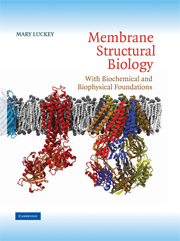Book contents
- Frontmatter
- Contents
- Preface
- 1 Introduction
- 2 The Diversity of Membrane Lipids
- 3 Tools for Studying Membrane Components: Detergents and Model Systems
- 4 Proteins in or at the Bilayer
- 5 Bundles and Barrels
- 6 Functions and Families
- 7 Protein Folding and Biogenesis
- 8 Diffraction and Simulation
- 9 Membrane Enzymes and Transducers
- 10 Transporters and Channels
- 11 Membrane Protein Assemblies
- 12 Themes and Future Directions
- Appendix I Abbreviations
- Appendix II Single-Letter Codes for Amino Acids
- Index
- References
8 - Diffraction and Simulation
- Frontmatter
- Contents
- Preface
- 1 Introduction
- 2 The Diversity of Membrane Lipids
- 3 Tools for Studying Membrane Components: Detergents and Model Systems
- 4 Proteins in or at the Bilayer
- 5 Bundles and Barrels
- 6 Functions and Families
- 7 Protein Folding and Biogenesis
- 8 Diffraction and Simulation
- 9 Membrane Enzymes and Transducers
- 10 Transporters and Channels
- 11 Membrane Protein Assemblies
- 12 Themes and Future Directions
- Appendix I Abbreviations
- Appendix II Single-Letter Codes for Amino Acids
- Index
- References
Summary
Important tools for structural determination of membrane components include x-ray and neutron diffraction techniques. While the most familiar use of x-ray diffraction is the solution of crystal structures providing high-resolution structures of proteins and lipids in crystalline arrays, other diffraction techniques can provide structural information on membranes or reconstituted systems with lipids in the fluid phase. Such membrane diffraction studies give information that is one-dimensional, normal to the bilayer plane, because of the liquid nature of the acyl chains. The constant motions of lipids in the Lα phase (see Chapter 2) introduce several types of disorders (Figure 8.1) that prevent precise delineation of their structure at atomic resolution and invite description of their dynamic properties by sophisticated computer modeling. Today the interplay between diffraction techniques and simulation methods contributes even more to understanding the structure of the fluid membrane. This chapter describes diffraction and simulation methods as they apply to the lipid bilayer and then looks at the lipids that are resolved in crystal structures of membrane proteins. It will close with a few comments on the art of crystallography of membrane proteins, which allows solution of their high-resolution structures. The following chapters illustrate how x-ray crystallography of membrane proteins is providing insights toward detailed understanding of their structure and functions.
BACK TO THE BILAYER
A starting point to depict the lipids in a bilayer is a view of the static structures obtained from x-ray crystallography of several pure lipids in crystalline phase (Figure 8.2).
- Type
- Chapter
- Information
- Membrane Structural BiologyWith Biochemical and Biophysical Foundations, pp. 191 - 212Publisher: Cambridge University PressPrint publication year: 2008



